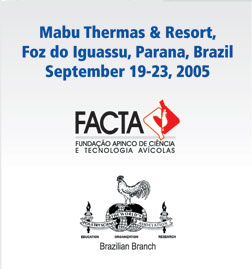Contributed Papers: Oral Presentations
Diagnosis and Epidemiology |
MOLECULAR GENOTYPING OF
EIMERIA TENELLA AND E. ACERVULINA THROUGH MICROSATELLITE MARKERS
A.P. Viotti1, S. Fernandez1,2, T.J.P. Sobreira1, J. Solis2 & A. Gruber1,*
1Faculty of Veterinary Medicine and Zootechny, University of São Paulo; 2Laboratório Biovet S/A, Brazil
*argruber@usp.br
Chicken coccidiosis is caused by seven species of the genus
Eimeria. Species identification can be accurately attained using either classical biological and morphological features, or molecular targets for PCR amplification. On the other hand, strain differentiation remains a complex task due the lack of good morphological/biological discriminative features. In addition, the only available molecular assays rely on DNA fingerprinting (Southern blotting) and RAPD. The former technique is tedious and time-consuming, and the latter presents low reliability and reproducibility across different laboratories. The aim of the present work was the development of reliable microsatellite markers for the intra-specific discrimination of two of the most relevant
Eimeria species: E. acervulina and E. tenella. In order to select potential candidate loci, we employed genomic sequences of the E. tenella Genome Project (http://www.sanger.ac.uk/Projects/E_tenella/) and also E. acervulina open reading frame EST (ORESTES) sequences generated in our laboratory (http://www.lbm.fmvz.usp.br/eimeria/). The sequences were analyzed with the program Tandem Repeats Finder, and the best candidates were selected using TRAP, the Tandem Repeat Analysis Program (Sobreira, T.J.P.; Durham, A.M. & Gruber, A. - manuscript in preparation). TRAP was developed in our laboratory as a bioinformatic tool for selection, classification and quantification of tandemly repeated sequences. The best candidate markers were chosen and primers pairs flanking the microsatellite repeats were designed. From a total of 57 markers tested for E. acervulina, 16 presented both species-specificity and intra-specific polymorphism, with an average of 2.8 alleles per locus. For E. tenella, 79 markers were screened, yielding a total of 15 polymorphic loci, with an average of 2.1 alleles per locus. Taking these data together, the microsatellite markers obtained so far allow for the theoretical differentiation of more than 7 million haplotypes for E. acervulina and circa 70,000 for E. tenella. We intend to extend this microsatellite development to E. maxima, another relevant pathogenic species of the domestic fowl, and to reach a theoretical differentiation of at least 1 million haplotypes for each species. Among the possible applications of this technology, we can cite the detection of the unauthorized use of commercial strains, discrimination between field and vaccine strains, purity control of vaccine strains on production, and field monitoring of vaccine propagation and crossing with field strains.
Financial support: FAPESP and Laboratório Biovet S/A
